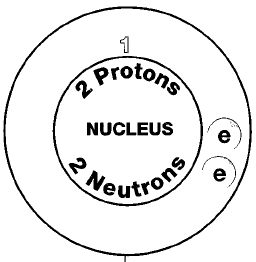HELIUM


Overview
Helium is a member of the noble gas family. The noble gases are the elements in Group 18 (VIIIA) of the periodic table. The periodic table is a chart that shows how the elements are related to one another. The noble gases are also called the inert gases. Inert means that an element is not very active. It will not combine with other elements or compounds. In fact, no compounds of helium have ever been made.
Helium is the second most abundant element in the universe. Only hydrogen occurs more often than helium. Helium is also the second simplest of the chemical elements. Its atoms consist of two protons, two neutrons, and two electrons. Only the hydrogen atom is simpler than a helium atom. The hydrogen atom has one proton, one electron, and no neutrons.
Helium was first discovered not on Earth, but in the Sun. In 1868 French astronomer Pierre Janssen (1824-1907) studied light from the Sun during a solar eclipse. He found proof that a new element existed in the Sun. He called the element helium.
SYMBOL
He
ATOMIC NUMBER
2
ATOMIC MASS
4.002602
FAMILY
Group 18 (VIIIA)
Noble gas
PRONUNCIATION
HEE-lee-um
Helium has some interesting and unusual physical properties. For example, at very low temperatures it can become superfluid.

For an inactive gas, helium has a surprising number of applications. It is used in low-temperature research, for filling balloons and dirigibles (blimps), to pressurize rocket fuels, in welding operations, in lead detection systems, in neon signs, and to protect objects from reacting with oxygen.
Discovery and naming
One of the most powerful instruments for studying chemical elements is the spectroscope. The spectroscope is a device for studying the light produced by a heated object. For example, a lump of sodium metal will burn with a yellow flame. The flame looks quite different, however, when viewed through a spectroscope.
A spectroscope contains a triangular piece of glass (called a prism) that breaks light into its basic parts. These basic parts consist of a series of colored lines. In the case of sodium, the yellow light is broken into a series of yellow lines. These lines are called the element's spectrum. Every element has its own distinctive spectrum.
The spectroscope gives scientists a new way of studying elements. They can identify an element by recognizing its distinctive spectral lines even when they can't actually see the element itself.
This principle led to the discovery of helium. In 1868, Janssen visited India in order to observe a full eclipse of the Sun. A solar eclipse occurs when the Moon comes between the Sun and the Earth. The Moon blocks nearly all of the Sun's light. All that remains is a thin outer circle (corona) of sunlight around the dark Moon. Solar eclipses provide scientists with an unusual chance to study the Sun.
Janssen examined light from the Sun with a spectroscope. As he looked at the spectral lines, he was surprised to see some lines that could not be traced to any known element. He concluded that there must be an element on the Sun that had never been seen on Earth. The name helium was later suggested for this element. The name comes from the Greek word helios for "sun."
French astronomer Pierre Janssen discovered helium after studying the Sun during a full solar eclipse.
Chemists did not know what to make of Janssen's discovery. Was there an element on the Sun that did not exist on Earth? Had he made a mistake? Some scientists even made fun of Janssen.
For the next thirty years, chemists looked for helium on Earth. Then, in 1895, the English physicist Sir William Ramsay (1852-1916) found helium in a mineral of the element uranium. Credit for the earthly discovery of helium is sometimes given to two other scientists also. Swedish chemists Per Teodor Cleve (1840-1905) and Nils Abraham Langlet also discovered helium at about the same time in a mineral called cleveite.
Ramsay did not know why helium occurred in an ore of uranium. Some years later, the reason for that connection became obvious. Uranium is a radioactive element. A radioactive element is one that breaks apart spontaneously. It releases radiation and changes into a new element.
Ernest Rutherford | English physicist

T hat's the last potato I'll ever dig!" That statement was attributed to young Ernest Rutherford, a native of New Zealand. Rutherford had applied for a scholarship to Cambridge University, one of England's most famous universities. Rutherford had actually finished second in the scholarship competition. But the winner had decided to stay in New Zealand and get married. When Rutherford was told he had won the scholarship, he threw down his potato fork and announced the end of his potato-digging days.
Rutherford went on to become one of the great scientific figures of the twentieth century. He made a number of important discoveries about the structure of atoms and about radioactivity. For example, he found that an atom consists of two distinct parts, the nucleus and the electrons. He also discovered one form of radiation given off by radioactive materials: alpha particles. Alpha particles, he found, are simply helium atoms without their electrons.
Rutherford was also the first scientist to change one element into another. He accomplished this by bombarding nitrogen gas with alpha particles. Rutherford found that oxygen was formed in this experiment. He had discovered a way to convert one element (nitrogen) into a different element (oxygen). The method Rutherford used later became a standard procedure used by many other scientists.
One form of radiation produced by uranium consists of alpha particles. Alpha particles are tiny particles moving at very high rates of speed. In 1907, English physicist Ernest Rutherford (1871-1937) showed that an alpha particle is nothing more than a helium atom without its electrons. As uranium atoms broke apart, then, they gave off alpha particles (helium atoms). That is why helium was first found on Earth in connection with uranium ores.
Physical properties
Helium is a colorless, odorless, tasteless gas. It has a number of unusual properties. For example, it has the lowest boiling point of any element, -268.9°C (-452.0°F). The boiling point for a gas is the temperature at which the gas changes to a liquid. The freezing point of helium is -272.2°C (-458.0°F). Helium is the only gas that cannot be made into a solid simply by lowering the temperature. It is also necessary to increase the pressure on the gas in order to make it a solid.
At a temperature of about -271°C (-456°F), helium undergoes an unusual change. It remains a liquid, but a liquid with strange properties. Superfluidity is one of these properties. The forms of helium are so different that they are given different names. Above -271°C, liquid helium is called helium I; below that temperature, it is called helium II.
Chemical properties
Helium is completely inert. It does not form compounds or react with any other element.
Occurrence in nature
Helium is the second most abundant element after hydrogen in the universe and in the solar system. About 11.3 percent of all atoms in the universe are helium atoms. By comparison, about 88.6 percent of all atoms in the universe are hydrogen. Thus, at least 99.9 percent of all atoms are either hydrogen or helium atoms.
By contrast, helium is much less abundant on Earth. It is the sixth most abundant gas in the atmosphere after nitrogen, oxygen, argon, carbon dioxide, and neon. It makes up about 0.000524 percent of the air.
It is probably impossible to estimate the amount of helium in the Earth's crust. The gas is produced when uranium and other radioactive elements break down. But it often escapes into the atmosphere almost immediately.
Isotopes
Two isotopes of helium occur naturally, helium-3 and helium-4. Isotopes are two or more forms of an element. Isotopes differ from each other according to their mass number. The number written to the right of the element's name is the mass number. The mass number represents the number of protons plus neutrons in the nucleus of an atom of the element. The number of protons determines the element, but the number of neutrons in the atom of any one element can vary. Each variation is an isotope.
Three radioactive isotopes of helium have been made also. A radioactive isotope is one that breaks apart and gives off some form of radiation. Radioactive isotopes are produced when very small particles are fired at atoms. These particles stick in the atoms and make them radioactive.
None of the radioactive isotopes of helium has any commercial application.
Extraction
In theory, helium could be collected from liquid air. Liquid air is air that has been cooled to a very low temperature. All of the gases in air have liquefied in liquid air. If the liquid air were allowed to evaporate, the last gas remaining after all other gases had evaporated would be helium. There is too little helium in air to make this process worthwhile, however.
There is a much better source of helium. The gas often occurs along with natural gas in reservoirs deep beneath the Earth's surface. When wells are dug to collect the natural gas, helium comes to the surface with the natural gas. Then, helium can be separated from natural gas very easily. The temperature of the mixture is lowered, and the natural gas liquefies and is taken away. Gaseous helium is left behind.
Helium often occurs along with natural gas in reservoirs deep beneath the Earth's surface.
About 80 percent of the world's helium is in the United States. In 1996, 20 U.S. plants produced helium from gas wells. About 86 percent of U.S. helium comes from five large underground regions: the Hugoton Field that lies beneath Kansas, Oklahoma, and Texas; the Keyes Field in Oklahoma; the Panhandle and Cliffside Fields in Texas; and the Ridley Ridge area in Wyoming.
For many years, the U.S. government operated the Federal Helium Program. This program was responsible for collecting and storing helium for government use. The main customers for this helium were the Department of Defense, the National Aeronautics and Space Administration, and the Department of Energy. The helium was stored underground in huge natural caves.
In 1996, the government decided to end this program. Helium was no longer regarded as essential to national security. The Bureau of Mines has begun to sell off the federal reserves.
Uses
The most important single use for helium in the United States is in low-temperature cooling systems. This is because liquid helium—at -270°C—s cold enough to cool anything else. For example, it is used in superconducting devices.
A superconducting material is one that has no resistance to the flow of electricity. Once an electric current begins to flow in the material, it will continue to flow forever. No energy is wasted in moving electricity from one place to another. Superconducting materials may revolutionize electrical systems worldwide someday. The problem is that superconductivity occurs only at very low temperatures. One way to achieve those temperatures is with liquid helium.
Another important use of helium is in pressure and purge systems. In many industrial operations, it is necessary to pressurize a system. The easiest way to do that is to pump a gas into the system. But the gas should not be one that will react with other substances in the system. Being inert, helium is a perfect choice. Helium is also used for purging, a process that sweeps away all gas in a container. Again, helium is used because it does not react with anything in the container.
Helium is used to inflate balloons and other lighter-than-air crafts, such as dirigibles (blimps).
Because of its inactivity, helium is also used in welding systems. Welding is the process by which two metals are heated to high temperatures in order to join them to each other. Welding rarely works well in "normal" air. At high temperatures, the metals may react with oxygen to form metal oxides. If they do, they are less likely to join to each other. If the welding is done in a container of helium, this is not a problem. The metals will not react with helium. They will simply join to each other.

Helium is also used in leak-detection systems. If a leak is suspected in a long pipe, helium can be used to look for that leak. It is pumped into one end of the pipe. A detector is held outside the pipe. The detector is designed to measure whether helium is escaping from the system. The detector is moved along the length of the pipe. It is possible to find out whether there is a leak, where it is, and how much it is leaking. Helium is a good gas to use for this purpose because it does not react with anything in the pipe.
Helium is also used to inflate balloons and other lighter-thanair crafts, such as dirigibles (blimps). Helium does not have the lifting power of hydrogen. However, hydrogen is flammable and helium is not. At one time, people thought that dirigibles would be a popular form of transportation. But that never happened. Blimps are still used for limited purposes, such as advertising at major sports and recreational events.
Compounds
No compounds of helium have ever been made.
Health effects
There are no known health hazards resulting from exposure to helium.
That's a more or less brief explanation about it. There's an entire physics behind it and that'll make a full understanding of it.
Thank you!